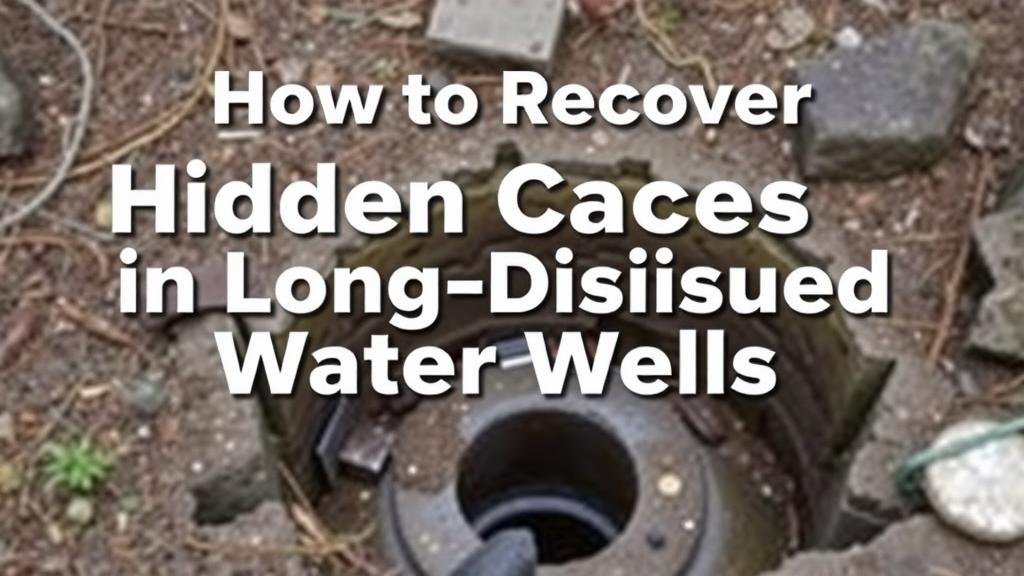How to Recover Hidden Caches in Long-Disused Water Wells
How to Recover Hidden Caches in Long-Disused Water Wells
Water wells served as critical resources for communities, especially in rural areas, for many years. But, many of these wells have become long-disused due to technological advancements, urban development, or changes in water sourcing. Interestingly, such wells might house hidden caches of valuable artifacts or historical remnants. This article provides comprehensive guidance on how to recover these caches while ensuring safety and regulatory compliance.
Understanding the Importance of Hidden Caches
Hidden caches in long-disused water wells can include a variety of items, from tools and relics that provide insight into historical lifestyles to materials that might hold financial value today. The recovery of such items not only contributes to our understanding of history but can also bolster local economies through tourism and research initiatives.
- Historical artifacts that illuminate past cultures
- Tools left by previous inhabitants, showcasing past technologies
- Mineral deposits or geological samples that can provide economic opportunities
For example, in a 2015 study conducted in Massachusetts, a team of archaeologists uncovered pre-Industrial Age items from an abandoned well, leading to new insights about the local inhabitants’ daily lives.
Assessing the Well Site
The first step in the recovery process is to adequately assess the well site. This involves both historical research and physical examination.
- Historical Research: Before physically examining the site, it is crucial to research the wells history. Consult local archives, historical societies, or libraries to gain insight into previous occupants of the area and the wells significance.
- Physical Examination: Inspect the surrounding area and any existing structures. Look for signs of previous access or disturbances that indicate past activity. Evaluate the water level and stability of the well casing.
Advanced methods such as ground-penetrating radar (GPR) may also be utilized to identify the presence of artifacts without invasive digging.
Legal Considerations
Before proceeding with any recovery efforts, it is essential to understand the legal implications. Wells are often under various regulations governed by environmental protection agencies and local laws.
- Obtain necessary permits before beginning work, especially if the well is located on public or protected land.
- Consult with local environmental agencies to ensure that recovery efforts do not disturb local ecosystems or violate historical preservation laws.
For example, in California, the Department of Water Resources has strict guidelines regarding abandoned wells to protect groundwater supplies from contamination.
Recovery Techniques
Once the legal framework is established, recovery techniques can be applied. Methods can range from manual excavation to high-tech imaging technologies.
- Manual Excavation: This method involves safely removing debris and sediment from the well bore. It is labor-intensive but allows for a hands-on approach to artifact recovery.
- Photography and Documentation: Regularly document the recovery process with photographs and notes to maintain a record of findings for future research.
- Professional Recovery Services: For valuable or historically significant finds, hiring professionals who specialize in archaeological recovery may be warranted.
An example of professional involvement can be seen in Ohio, where archaeological teams were contracted to recover artifacts from an abandoned well that was part of a historic irrigation system.
Safety Precautions
Safety is paramount when recovering items from disused wells. Various risks are involved, including structural instability and potential exposure to contaminants.
- Use protective gear such as gloves and masks to avoid exposure to pollutants.
- Ensure that the well’s structure is sound; engage professionals if there are concerns about cave-ins.
- Have a rescue plan in case of emergencies, including first-aid provisions and communication devices.
According to a 2020 report by the American Water Works Association, approximately 43% of wells that are abandoned present inherent risks, emphasizing the need for careful assessments and safety planning.
Documenting and Utilizing Findings
Once recovery is complete, documenting your findings is critical. Classifying and analyzing artifacts can provide an educational resource for local communities.
- Museum Displays: Collaborating with local museums to exhibit recovered items can enhance local history, attracting visitors and promoting cultural heritage.
- Educational Programs: Developing workshops or school programs based on the recovery findings can inform and engage younger generations about local history.
A notable example is the recovery effort in New York, where a cache of Revolutionary War-era items was preserved in a local museum, fostering community pride and educational outreach.
Conclusion
Recovering hidden caches in long-disused water wells is a complex, multifaceted process that requires careful planning, assessment, and adherence to regulations. By understanding the historical importance, adhering to legal requirements, employing appropriate recovery techniques, and ensuring safety, individuals and communities can unlock the potential of these forgotten resources.
Actively engaging with local historical societies and conservation agencies can foster collaborative efforts towards safely recovering and preserving our heritage. journey of uncovering hidden caches holds the promise of enriching our understanding of the past and providing valuable educational opportunities for the future.



